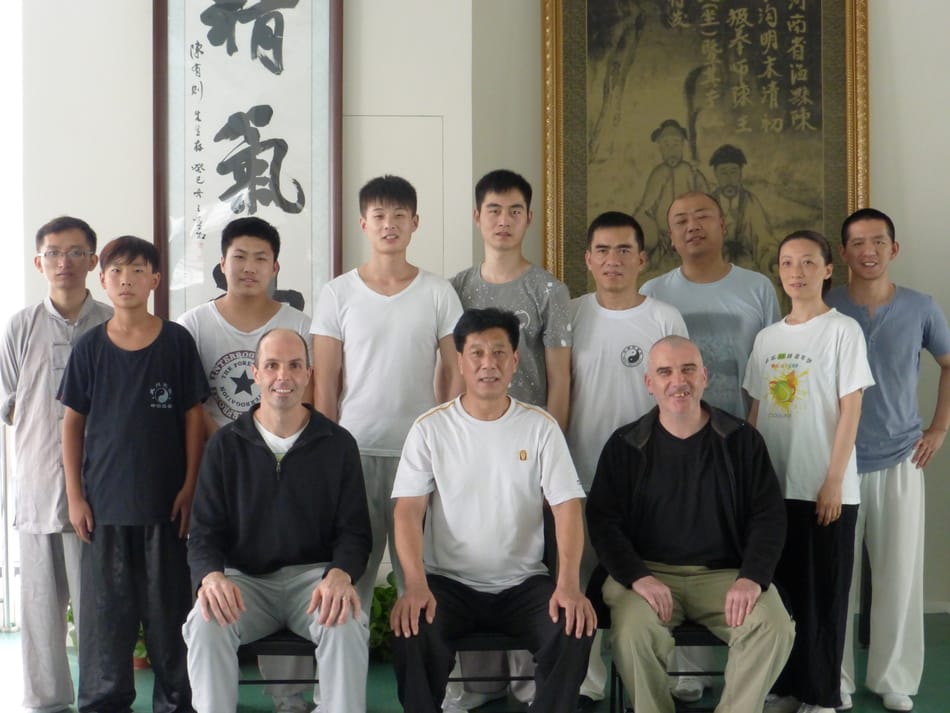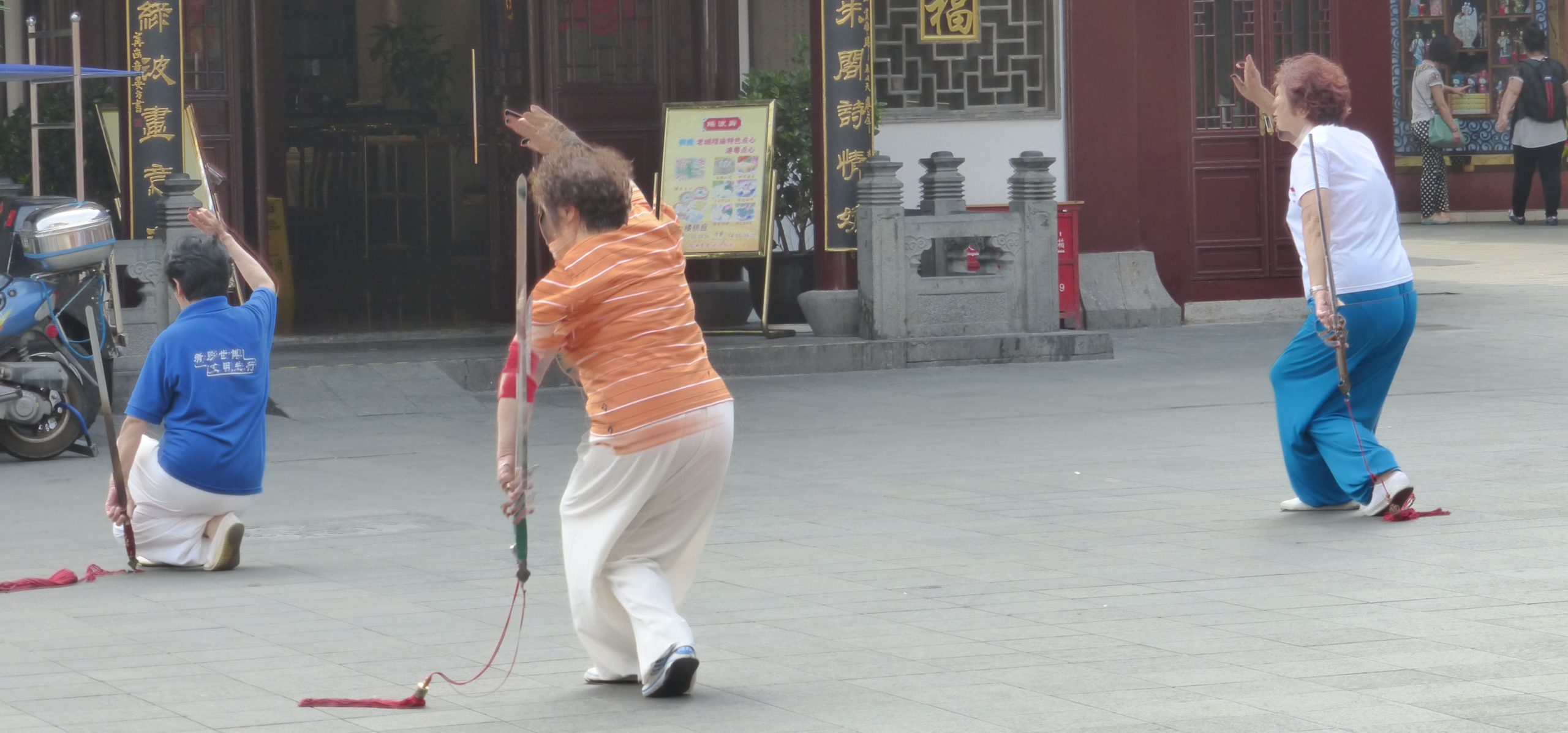I woke up on day two of a 3-week training trip to China feeling like I had been hit by a truck. The tai chi workout schedule the day before went from 7-11, 2-4, and 6-730ish. I thought I was in pretty good shape but had no idea what I had gotten myself into. And I had 20 days to go!!! I played high school sports, served in the military, and have lifted weights and worked out my whole life. By the end of those three weeks it was clear to me that not only could a tai chi workout routine put on muscle and get you in great cardio shape, but that it is probably the safest exercise I had ever experienced.
As a whole, you can get fit doing a tai chi workout that is designed to simultaneously build upper and lower body strength while correctly warming up muscles and joints. The focus on posture and breath make the movements exceptionally safe and can increase power because of correct structural alignment.
The guy I traveled with and I affectionately refer to that time as the “Beijing Beatdown” and I want to share three very important lessons I learned that are applicable no matter your age or level of tai chi. On it’s own, tai chi exercise is a good workout. Secondly, doing tai chi makes all your other physical activities more safe and more effective. Thirdly, the tai chi form can be modified (made more difficult!) to meet all of your fitness goals.
How Tai Chi is a Good Workout
You have so many options for getting in shape and trust me, I know tai chi is not high your list. Tai chi has done well to speak to an injured, older, or out-of-shape population as a sort of on-boarding to get back to the “good stuff.” Or, a replacement for a loved activity that you can no longer do. But what if tai chi is both something you can do for rehab and something you can do for the rest of your life? What if it is something that you can modify now to make harder if you are in good shape, or make easier because you are not? I will even go as far as to say that a tai chi workout will protect your body to allow you to keep doing whatever you love for longer.
A Tai Chi Workout Makes Whatever You Love Doing Better
In the West you see suggested pairings like cycling and running or cycle-into-yoga classes where one exercise acts as the polar opposite of the other. It stretches out what got tight, or uses the body parts that were not the focus of the primary activity. Everything physical that you do can benefit from pairing it with tai chi. Here’s how:
- Breath training means more oxygen for those swimming laps or running laps
- Great posture means no leaning into knee injuries and no sore neck
- The circular rotations mean synovial fluid in all joints
- The heightened concentration means more focus and makes you a better competitor
- Integrated, whole-body movement improves your swing, stride, or shot to the hoop
- Awareness of partners like in push hands means better court or field defense
- Low stance work leads to balance, power, and leg stamina
- Whole-body stretching of doing the form means faster recovery
I want to make something abundantly clear here: I am not talking about modifying your class’s tai chi workout yet or a separate tai chi exercise regime. You get all the benefits listed above just by doing the form as it has been taught for generations. But! What if you want to get fit or get more out of it?
Tai chi has all of the benefits of more aggressive exercise if you are being challenged by your posture, depth, and openness of posture. However it has the added benefit of 1) reducing the risk of torn muscles and 2) not stressing the heart.
Lecture notes: workshop with Grand Master chen Youze
How You Can Get Fit Doing Tai Chi
There are some general ways that you can modify the form to get an often extreme workout. We did this in China, often do it in workshops, and have now added it to our class at times depending on the attendees. Let’s talk about ways to impact specific health goals and how to use the tai chi forms to accomplish this. I am going to cover how each of these weapons are their own tai chi fitness workouts and then link out to separate articles on each of the weapons if you are interested in learning more.
The open-hand tai chi form builds mental and physical strength
Consider the open-hand form (weaponless) your go-to exercise if you want to improve a little of everything. It warms you up, stretches you out, and heals your tweaks. Two specific benefits of the open-hand form are increased focus and stamina. It can be mentally challenging to remember the moves, especially when doing it several times in a row. This improves concentration for whatever sport you are involved in. It is also difficult to continually move for 18-35 minutes. By not pausing, dealing with perfuse sweating, and increased fatigue, we improve stamina.
Tai chi straight sword for hamstring and quad strength
The straight sword is excruciating when done long enough with correct posture. The amount that you sweat, we’re talking huge droplets, and the amount of heat your legs produce is shocking when you are slowly, slowly (did I say slowly?) moving through the low postures. Something additional that I have experienced with a long tai chi workout using the sword is that it can release stress and toxins locked in the big muscles that at first make you feel ill but then make you feel great. Find out more about the straight sword.
The broadsword form develops cardio and balance
Simply put, you need to be able to do a 360 spin, jump in the air, travel between 1-2 meters, and land on one foot. The broadsword is fast, attacking, and dynamic. Learning the broadsword form dramatically improved my weight shifts in all other exercises and also opened my shoulders which translated into volleyball and the overhead press in powerlifting. Find out more about the broad sword.
The spear form develops cardio, lightness, and quick feet
If you are in a moving sport then the spear form is a pretty great addition. It is almost dancelike and is extremely fast with 75 moves happening in less than 3 minutes. A tai chi exercise workout using the spear is exhausting and at the same time requires extreme focus or you smack your shins or your groin with the staff! Not fun. Find out more about the spear.
The tai chi ball develops a strong back and great posture
Imagine squatting down and holding a 10-17 lb. object in front of you. How good does your posture have to be so that your back doesn’t get sore? Now image moving through 81 movements with that object held away from the body, sometimes while balancing on one foot. That’s the ball form. The ball form has continual squatting movements which is a heavy workout on the thighs. Find out more about the tai chi ball.
Standing meditation develops bone strength, posture, and resolve
I have saved the best and most painful for last. Zhan Zhuang or “pole standing” is 3 minutes of shear leg pain that innervates the production of white blood cells and bone marrow while raising the body’s temperature. It really can’t be described accurately without experiencing it. However, it is the cornerstone of tai chi training because it works to develop the root of the lower body with the lightness of the upper body. And Zhan Zhuang is easily something that you can add to your routine.
Creating Your Own Tai Chi Fitness Regime
Reading through the list above you begin to see how we were easily able to fill a training day with 7-10 hours of activity. I wouldn’t suggest this if you are starting out! I really want to go back to China to train again because I made so much progress but quite honestly, part of me is scared 🙂
There are ways you can adapt anything you currently practice by creating a tai chi exercise routine. You can even add music to enhance your practice. To get started, do your form multiple times in a row, do it lower, do it super fast, or do it super slow. The main point is to stretch yourself and stress yourself. The beautiful design of tai chi lends itself well to incremental increases in difficulty while keeping yourself completely free from injury.




